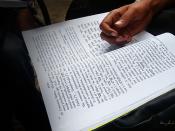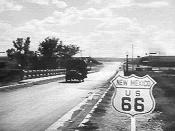John Steinbeck always makes it a point to know about his subjects first hand. His stories always have some factual basis behind them. Otherwise, he does not believe that they will be of any value beyond artistic impression. Therefore, most of his novels take place in California, the site of his birth and young life. In preparation for writing his novels, Steinbeck would often travel with people about whom he was going to write. The Grapes of Wrath was no exception to his other works. To prepare for it, he joined migrants in Oklahoma and rode with them to California. When he got to California, he lived with them, joining them in their quest for work. By publishing these experiences and trials of the migrants he achieved an effect that won him the Nobel Prize for literature in 1962. The writing of The Grapes of Wrath coincided with the Great Depression.
This time of hardship and struggle for the rest of America gave Steinbeck inspiration for his work. Other peoples' stories of everyday life became issues for Steinbeck. His writings spoke out against those who kept the oppressed in poverty and therefore was branded as a Communist because of his 'voice.' Although, it did become a bestseller and receive countless awards, his book was banned in many schools and libraries. However, critics never attacked The Grapes of Wrath on the artistic level and they still consider it a beautifully mastered work of art. More than any other American novel, it successfully
-1-
2
embodies a contemporary social problem of national scope in an artistically viable expression.1 In The Grapes of Wrath, Steinbeck utilizes Biblical imagery and allusions to illustrate the struggle of the Joad family as a direct parallel with that of the Hebrew people.
Steinbeck bolsters the strength of...


